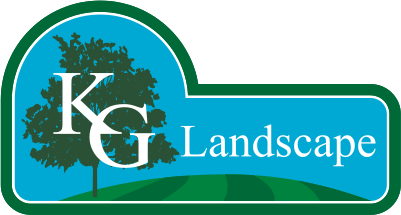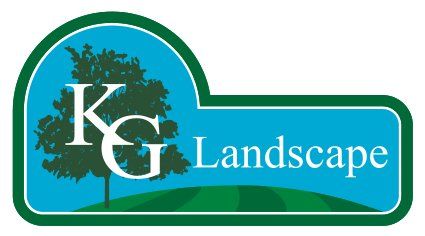Lakeshore Landscaping
Lakefront Landscape Design
Experience the ultimate in lakeside living as we create lakefront landscapes that blend seamless functionality with stunning beauty, providing you and your family with an unparalleled setting for leisure activities and awe-inspiring vistas.
Our lakeshore landscape designs cater to all ages and interests, ensuring that every member of your family can revel in the delights of waterfront living right from your own home.
Lakeshore Landscape Design Features Overview
The goal is to maximize the functionality and beauty of your lakeshore property. We start by helping our customers develop a cohesive plan, that checks off all of their design criteria boxes, meets the shoreline requirements and regulations, and offers a little more than the client imagined was possible.
We design and build landscapes that stand the test of time, so you that and your family can enjoy these wonderful spaces for many years to come.
Homes on the water offer fun family friendly activities, picturesque views and opportunities to create special outdoor spaces to unwind and relax. Imagine the sounds of the waves coming in, the crackling of a beachside fire and birds signing at dawn and dusk truly soothes the soul. However, lakefront which has been altered and cleared of natural vegetation for beaches, lawns, access leaves the shoreline particularly vulnerable to erosion and loss of property.
Lakeshore is an ecologically significant system that supports lake health. As a property owner and steward of the land, creating a dynamic space while protecting the lake can be visually pleasing and help while crafting a connection to the lake. It’s all about finding the right balance between the lake and the lawn.
Cohesive Landscape Design
We take a holistic approach to landscape design. During the design process we will discuss landscaping ideas that may become important aspects of your ideal design, such as: how landscape design might influence maintenance needs, current landscape trends, formal vs. informal design ideas, use of native plants, pollinator gardens, controlling run-off and erosion from the non-permeable surface areas like the roof and driveway, rain gardens, turtle friendly shorelines and deer resistant plant selections.
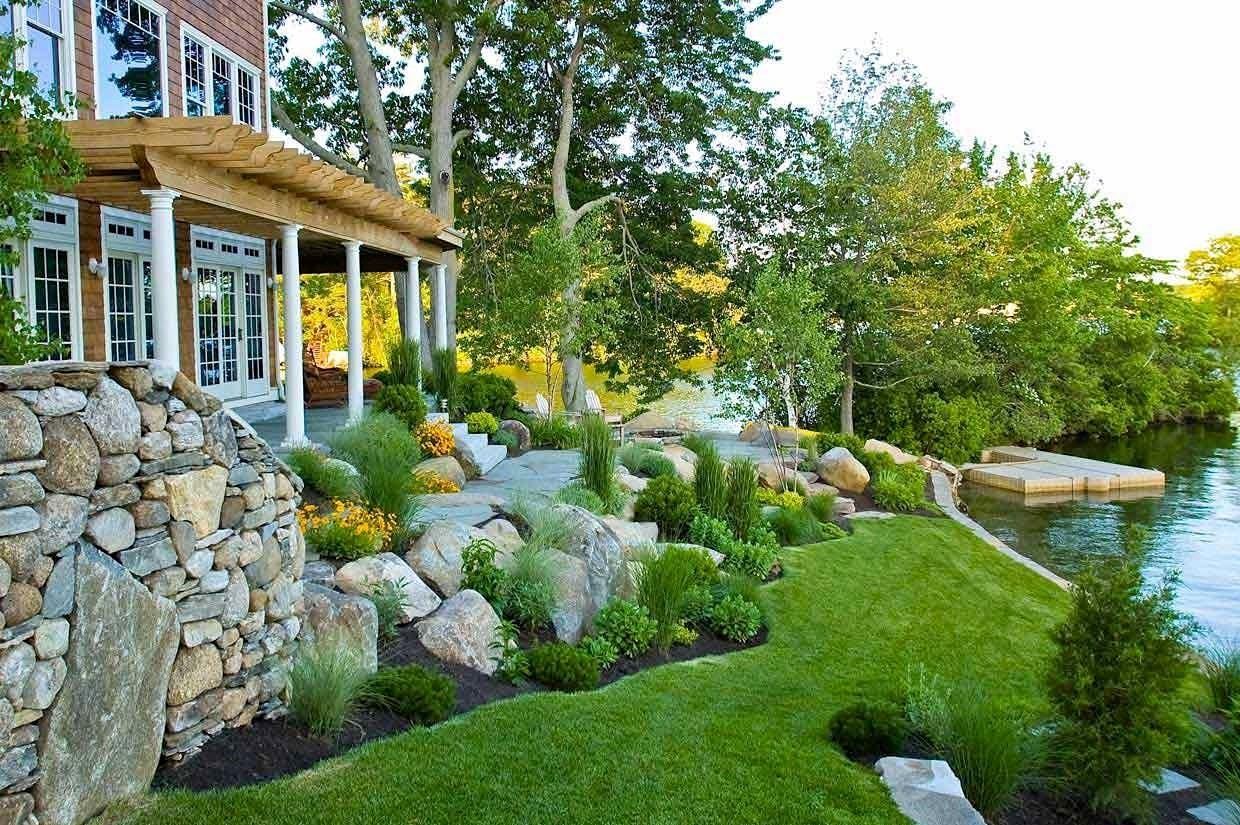
Lakeside Landscaping Features
A spectacular backyard is especially desirable for those who own lake property. The view of the yard from house and from the water yard should be scenic, yet still allow for activities such as boating, swimming and entertaining. Below, are some of the common design criteria to consider during the design process.
- Stairs/Steps
- from house/cabin to water
- from shore into the water
- Retaining walls
- Boulder walls
- Wave protection
- Fire Pit Spaces
- Patios / outdoor entertainment
- Pathways
- View Enhancement
- Dock Storage Space
- Hill Side Plantings
- Rip Rap
- Reduce erosion
- Reduce Mowing
- Creating useable lawn spaces
Blending these items together into a comprehensive plan that has great views to the lake, allows for active uses, and protects the shoreline is a challenge and a great design opportunity.
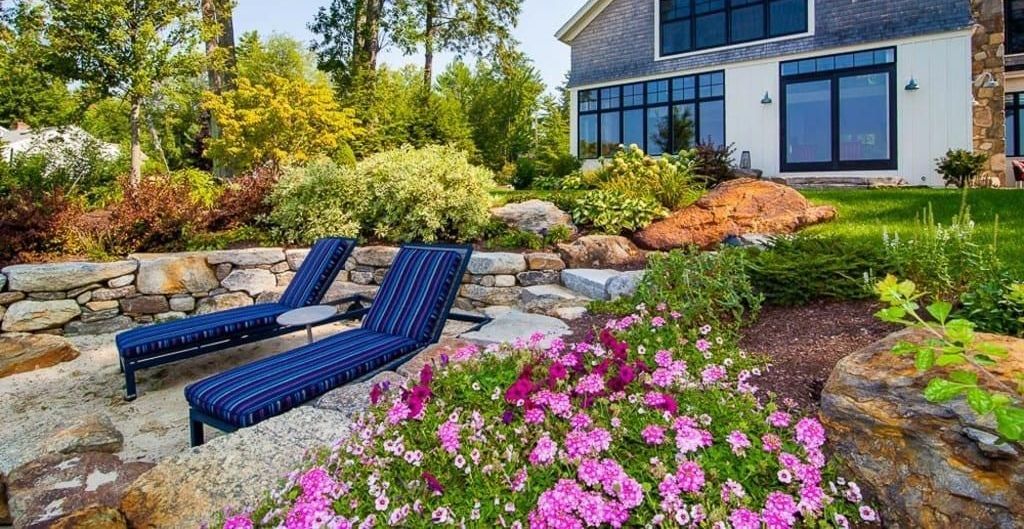
Backyard Beach / Swimming Area
The location of your house will largely determine the location and type of beach and swimming area you can design. From there you should consider things such as; the slope down to the lake, water depth, aquatic plant growth, soil type, and visibility from the house or patio spaces. The design of your beach and swimming area should be functional and aesthetically pleasing. Natural materials such as sand,
rocks, and plants to create a pleasing look.
Additional considerations such as safety and maintenance should be top priorities when designing a beach/swimming area. You may need to consider installing safety features such as fences, lifebuoys, and warning signs. Installing materials that are easy to clean and care for each summer will make the space low maintenance and much more appealing to use from season to season.
You may need permits from local authorities before you can start the installation of your beach and swimming area. You should check with your local authorities to find out what permits you’ll need for altering shoreline. KG will help with permitting work during the design process.
Lakeside Patios
Patios are a great way to create useable outdoor living space and build a stronger connection between your home and the lake. It adds an element of architectural appeal of your lakefront and creates an additional room. The patio should be visually appealing from the house without obstructing the view.
Patios are typically constructed at grade with hard materials like brick, concrete, stone tiles, and pavers. If you have a lake setting that sits on a slope, then a patio styled deck might be the perfect choice for you.
When designing lake side patios, it’s important to consider factors such as privacy, views, sun exposure, wind direction and drainage. You can also add features such as fire pits, outdoor kitchens, pergolas, and seating areas to make your patio more functional and comfortable for dining with family and friends or hosting larger gatherings. Visit our Patio Design page to learn more.
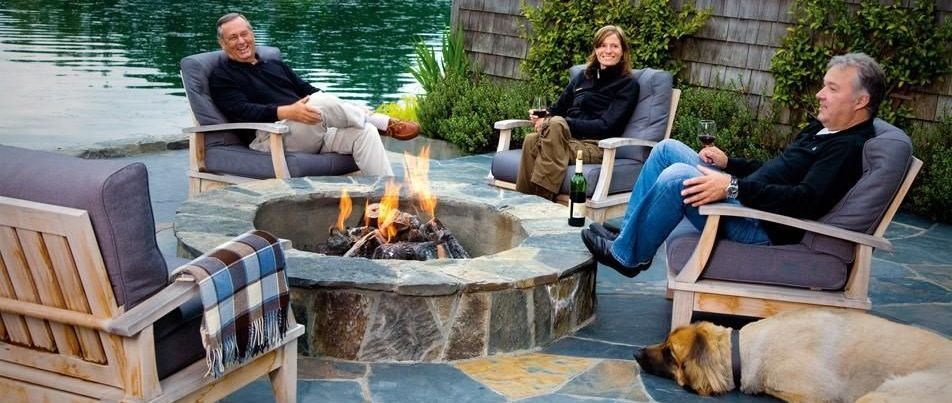
Fire Pit Spaces
The firepit area is the most popular way the to enjoy the lakefront space. By creating an outdoor living space that provides warmth, ambiance it becomes focal point for gatherings late in the day. Location, size, shape, style, materials and safety are several of the factors to take into consideration for the design. They can be part of a patio design or laid out on their own as a simple and rustic space.
The location of your firepit should complement the view of the lake and the layout of your property. Additionally, you should consider the direction of the wind, sun exposure, and drainage of the area. You should also think about how you will access your firepit from your house or patio, and how it will connect to other features of your landscape such as patios, seating areas, docks, etc. via pathways. Make sure your space is away from flammable structures (check your local codes), plants or other materials, and that has enough clearance around it for people to move comfortably.
The size of your firepit should match the scale of your space and the number of people you expect to use it. A typical firepit ring runs between 30” to 42” in diameter with other materials. You should also create enough room around the firepit for chairs or benches, and for people to walk around without bumping into each other or the fire. Use a 16’ diameter as a rule of thumb around the center to define the space needed and shape out your space from there.
The shape of your firepit can vary depending on your style and taste. You can choose from circular, square, rectangular or irregular shapes, or even create a custom design that reflects your personality or theme. Having an idea of what style of furnishings that you want to use on the space can help you decide on what the best shape for you. The shape of your firepit can also affect the airflow and the heat distribution, so you should consider these factors when making your decision.
The style of your firepit should blend in with the overall look and feel of your lakefront property. You can opt for a rustic, modern, traditional or eclectic style, depending on the materials and accessories you use. You can also add some decorative elements to your firepit, such as boulders, paver accents, or sculptures, to enhance its appearance and create visual interest.
The materials you use for your firepit should be durable, heat-resistant and weather-proof. Concrete pavers and block have a vast array of product material to fit any style, and along with natural stone and boulders are highly popular choices. You should also consider the fuel source for your firepit, whether it is wood, gas or propane. Each option has its own advantages and disadvantages in terms of cost, convenience and environmental impact.
A lakefront firepit can be a wonderful feature for your outdoor living space if you design it carefully and thoughtfully. By following these tips, you can create a firepit that is safe, functional and beautiful.
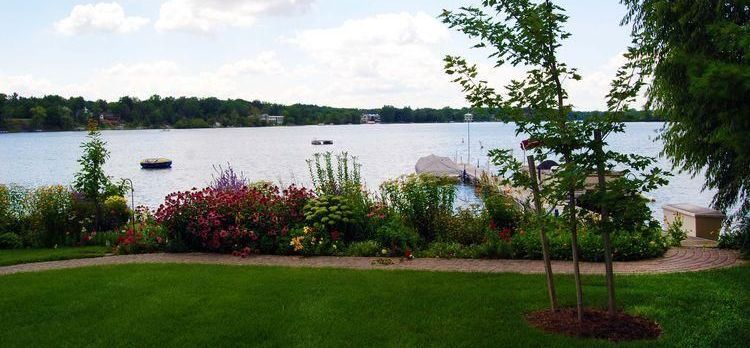
Lakeside Pathways & Footpaths
Designing pathways from house to lakefront is a challenging task that requires careful planning and consideration of various factors. Some of the factors that need to be taken into account are: The slope and terrain of the land. If possible, pathways should be designed to avoid steep or uneven areas that could pose a safety hazard or difficulty for walking or cause erosion to the slope. The pathway should also blend in with the natural landscape and minimize environmental and visual impacts.
The materials of the pathway should complement the character of the house and amenities that it is connecting to. The pathway should also reflect the personality and taste of the homeowners, whether they prefer a formal or informal, rustic or modern, or simple or elaborate style. Common materials for pathways include crushed rock, pavers and stone.
Pathways should serve the needs and preferences of the users, whether they want to access the lake for recreation, relaxation, or other purposes. The pathway should also provide adequate lighting, drainage, and secure footing.
Many properties along rivers and lakes have steep transitions at various points from the house or cabin down to the waterfront. Some properties have steep consistent slopes from the top all the way down to the water. Others have slope breaks where only short transitions are needed to traverse down in places or get down from a retaining wall to reach the water.
Designing lakefront stairs/steps down to a lake requires thoughtful planning and consideration of several factors. The slope and elevation of the land will heavily determine the size, type, and materials used for structure. The staircase/steps should follow the natural contour of the land and avoid steep or uneven sections that could pose a safety hazard or damage the environment.
The materials used should be durable, weather-resistant and aesthetically pleasing. They should also match the style and purpose of the lake house or cabin. For example, wooden stairs may suit a rustic or natural setting, while metal or concrete stairs may be more suitable for a modern or minimalist design.
The stairs/steps should be wide enough and have enough clearance to accommodate the expected traffic and use and should have a comfortable and consistent rise and run (the height and depth of each step). The stairs/steps should also have adequate lighting, handrails, guardrails and nonslip surfaces to prevent accidents and injuries. Double check to make sure that they comply with local building codes and accessibility requirements.

Rip Rap Protection
Rip rap is a common method of protecting lakeshore from erosion caused by waves, ice, and fluctuating water levels. Rip rap consists of large, angular rocks that are loosely placed along the shoreline, parallel to the water, forming a barrier that absorbs the impact of water and stabilizes the soil.
Rip rap can be enhanced by planting native vegetation between the rocks, which can greatly improve the appearance and habitat value of the shoreline. Rip rap is an effective way of preserving lakeshore property and preventing further erosion to your property’s shoreline.
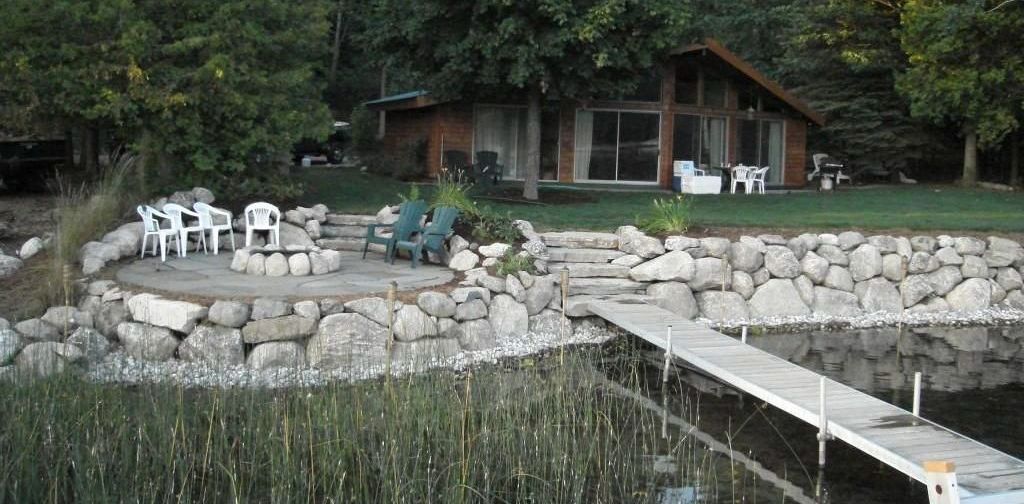
Shoreline Retaining Walls
A more intensive way to protect the shorelines of waterfront properties from erosion, flooding, and provide wave protection is to construct retaining walls. They are usually built parallel to the water's edge, using materials such as boulders or modular precast concrete wall block. Retaining walls can be designed to enhance the aesthetic appeal of your lake front property and to match the landscape and architecture of your home or cabin.
Of the different types of walls that we build, boulder walls are among the most common and affordable. Boulder walls are a great way to enhance the beauty and functionality of your waterfront property. They provide erosion control, shoreline stabilization, and natural habitat for aquatic life. Boulder walls are also durable, low-maintenance, and environmentally friendly. They can be customized to fit your landscape design and personal preferences. Whether you want a rustic or modern look, lake front boulder walls can create the perfect setting for your outdoor living space.
Modular concrete block retaining walls are another durable solution. The interlocking concrete blocks can be customized to fit any shape and size of lake front property. They are easy to install and maintain, and have a wide material and color selection to fit any number of design styles. Modular retaining walls also offer many benefits such as increasing the usable land area, the added ability to create terraces and steps, enhancing the aesthetic appeal, and protecting the water quality.
Dock/Location & Storage Area
The dock is a highly important space and active area for most lake property owners. Where you locate the dock will depend on how you want it to interact with the site’s other spaces. Some questions you may to ask yourself in the beginning; How do you want the dock to appear in your space? Is the dock used as an extension of patio and deck space for seating or activities? Do you want it in plain view of the house as part of the aesthetic or for safety purposes? What kind of access do I need to it? From there you can move towards what type of dock you want.
The size and shape of the dock will depend on several different factors. A permanent crib or pipe style dock will require no seasonal storage space which reduces the need for a storage footprint on shore. Floating and roll in docks will require space on shore to store in the off season. Additionally, the dock’s design and layout in itself will factor on the number and type of boats, need for a boat lift or boat house, trailer access, and other intended uses of the dock space for things like swimming, fishing, seating and sun bathing. You’ll also want to consider the maintenance factors of each style.
Local codes may also set maximum numbers for type, size/length and usage. Obtaining approval from the lake authority and/or the Department of Natural Resources may be necessary part to following the zoning, setback requirements, respecting the wildlife and habitat protection measures.
Even with permanent docks you will want to consider a storage space for tools, equipment, recreational gear, etc. that you don’t want left about. Consider what items will need to be stored such as canoes, kayaks, cleaning equipment, life jackets, etc. and how they need to be stored. You’ll storage fairly close to the docks and outdoor living spaces but designed in a way that it adds a sense of character to the site or tucked away as to not obscure any views.
Sustainable Lakeshore Landscaping Design Concepts
Cohesive Design Plans
Our sustainable lakeshore landscaping designs not only meet regulatory requirements but also offer an environmentally friendly approach to enhancing your property. With our meticulous planning, we create stunning lakeshore landscapes that seamlessly blend with the natural surroundings while exceeding expectations. Let us elevate the aesthetic appeal of your lakeshore property in a way that respects and preserves the beauty of the environment.
Sustainable Design Process Steps
The first steps are determining the clients overall design criteria, budget and design style, etc. This is followed by a site visit to see firsthand the issues and opportunities the site presents such as existing views, vegetation, erosion issues etc. Learn more about our design process.
Following the site visit we would then need to perform due diligence on the site to see what design standards need to be followed prior to permitting and construction such as shoreland assessments or development standards and requirements such as setbacks and Best Management Practices that must be adhered to. Once this has been established, we then move into the conceptual design phase
Enhancing Lake Views Responsibly
All too often all shoreline vegetation gets stripped away to offer a full unobstructed view of the lake and to reduce the maintenance of the yard. But consider this, by stripping away that vegetation you leave the lake front mostly barren of the beauty nature provided and stripped of what makes that view spectacular in the first place. It also opens it up to possibly more work and effort in costly repairs restoration efforts down the line. Consider instead, retaining the best qualities by:
- Opening up only selective views
- Removing invasive or degraded vegetation
- Mature trees frame and enhance view
- Enhancing key spaces with dynamic landscape beds
- Using buffers and no mow areas to create a transition to the water significantly lower maintenance, and enhance views
- Protect property from ice damage
Improve Water Quality
One of the primary reasons lake associations encourage shoreline improvements such as buffers and no mow areas is that manicured lawns running up to the water’s edge have unintended consequences on a lake’s health and habitat such as:
- Excess runoff
- Soil loss and erosion
- Bank stabilization issues
- Pesticides
- Algae blooms from excess fertilizers and grass clippings
- Slope degradation
By addressing these issues and eliminating or reducing these inputs will make the lake experience that much better in the end with cleaner water and a more sustainable ecosystem.
Improve Your Lakefront by using Best Management Practices
Best management practices (BMPs) are established methods for protecting water quality and furthering soil protection. Some established practices for shoreline include:
- Minimum 15-25’ vegetated buffer at the shore
- No-mow native grass and forb (wildflower) zones
- Meandering paths and steps to reduce infiltration and erosion
- Multi-layered lake-scape gardening with native plants
Establish Buffers to Create Space for Wildlife & Stabilize Banks
Natural shoreland buffers have been lost in many places. Restoring them can improve water quality, bank stability, wildlife habitat and aesthetics around the state’s lakes and ponds. Some of the benefits of buffers include:
- Filters sediment, traps pollutants and pesticide residue, and absorbs excess nutrients such as phosphorus and nitrogen from fertilizer from excess runoff.
- Recharges groundwater and helps mitigate flooding by absorbing stormwater runoff.
- Helps to stabilize and protect banks from stormwater runoff and wave action erosion.
- Provides shade, woody debris, and nutrients to shallow-water ecosystems to improve habitat for aquatic life.
- Provides essential pollinator and wildlife habitat and corridors.
- Provides specialized habitat for rare, threatened, and endangered plants and other species.
- Can improve the economic value of the property through functional stability and aesthetics.
- To learn more, check our our detailed blog on Shoreline Restoration and erosion control.
Create ‘No Mow Zones’ to Improve Water Quality
No mow zones are the easiest way to establish a vegetative buffer between the lake front and your lawn. A shoreline specific native grass buffer with wildflower forbs interspersed will look naturalistic. The deep-rooted vegetation will help mitigate erosion and filter contaminates from runoff. When suitably designed it can look amazingly organized and defined.
In addition to a buffer zone right along the shoreline itself, replacing a standard high input bluegrass lawn with a low mow lawn can further reduce runoff, eliminate or reduce fertilization and herbicide usage needs and require less watering. Both clover and fescue low mow lawns are far more drought tolerant than a typically bluegrass
Visit our blog to Learn more about Low mow and Bee friendly lawns.
Seed in ‘Low Mow Lawns’ to Reduce Maintenance
If maintenance is a concern or something that you would like to reduce, consider using a low mow lawn mix throughout your property. The deeper roots are better for soil, it requires little to no fertilizer, uses little as far as herbicides and when used with clover, and other forbs is good for pollinators.
Additional Resources
MN DNR Shoreland Information for Property Owners - FAQ and links to shoreline lot regulations in Minnesota.
